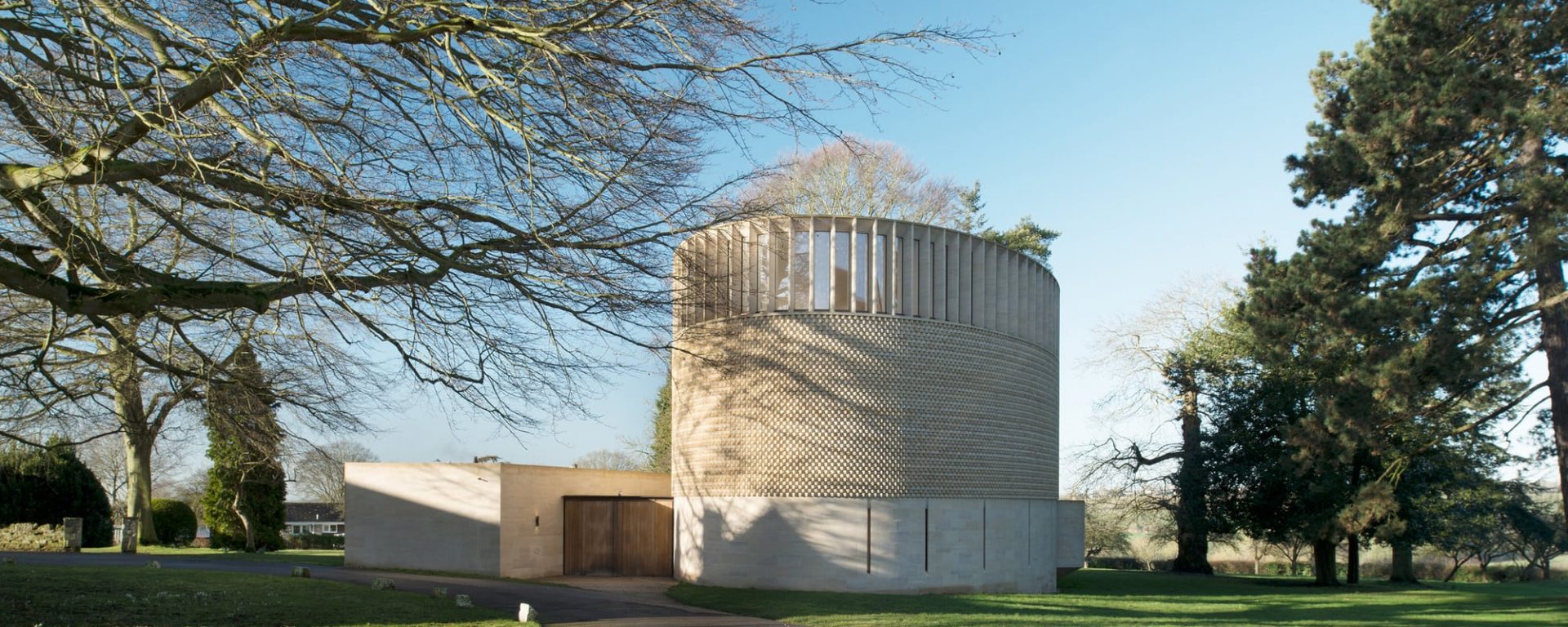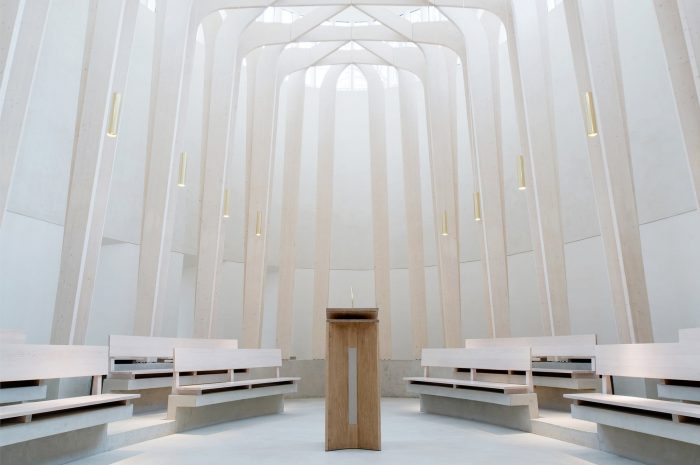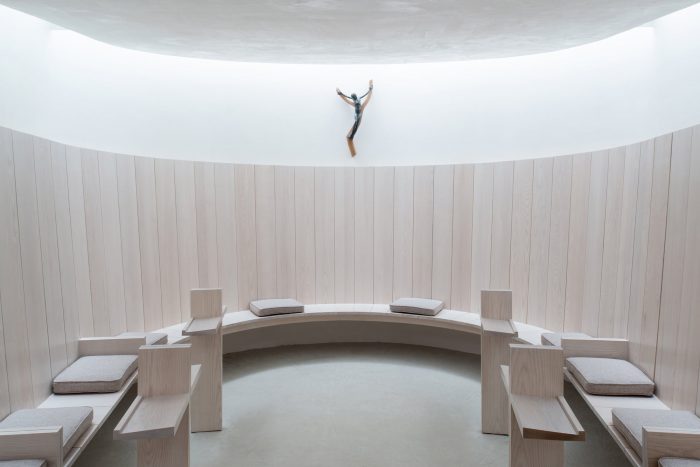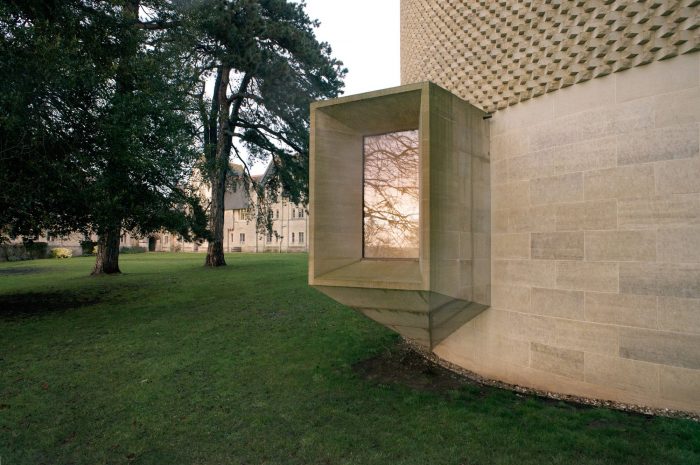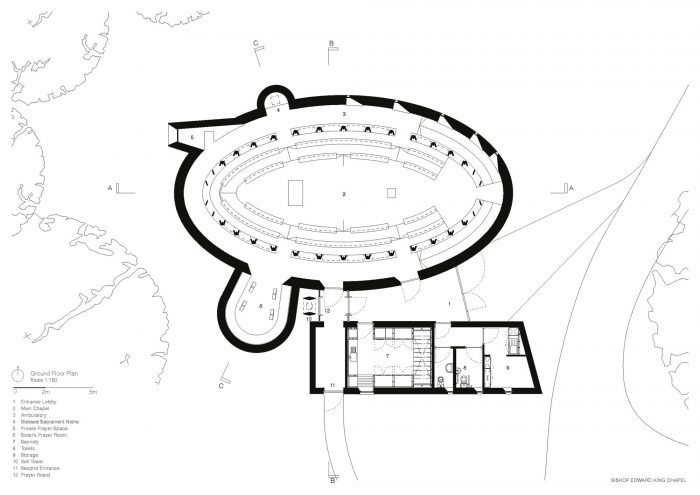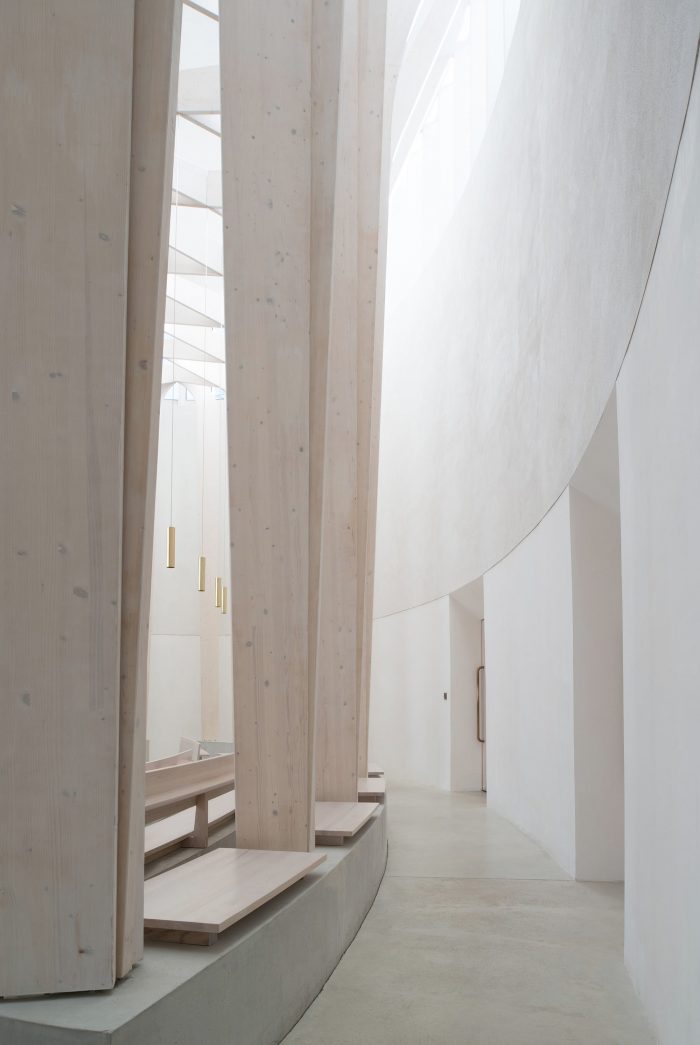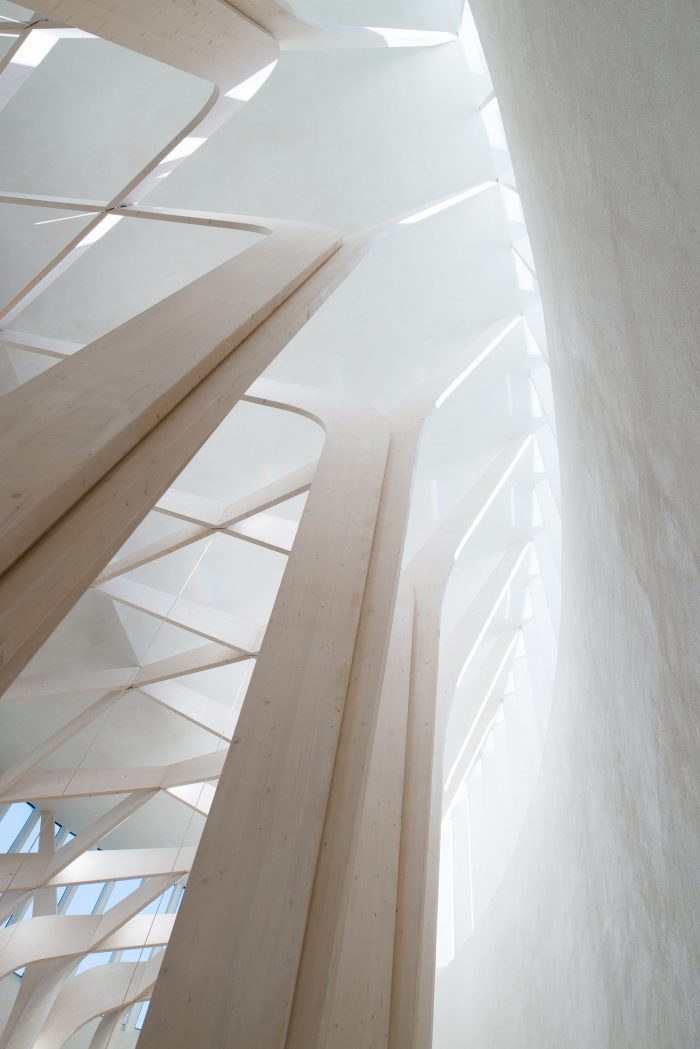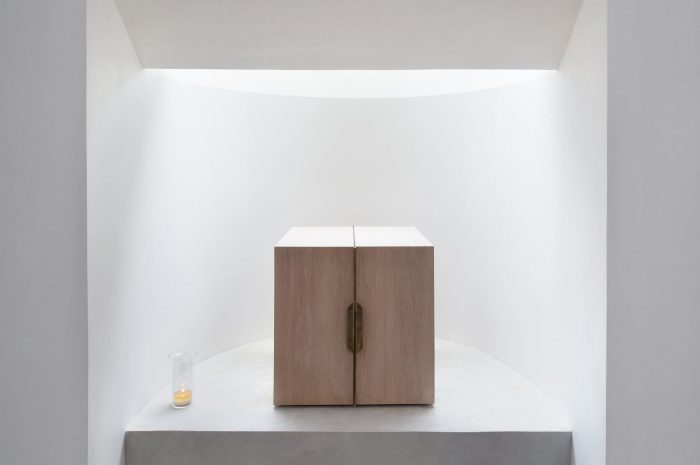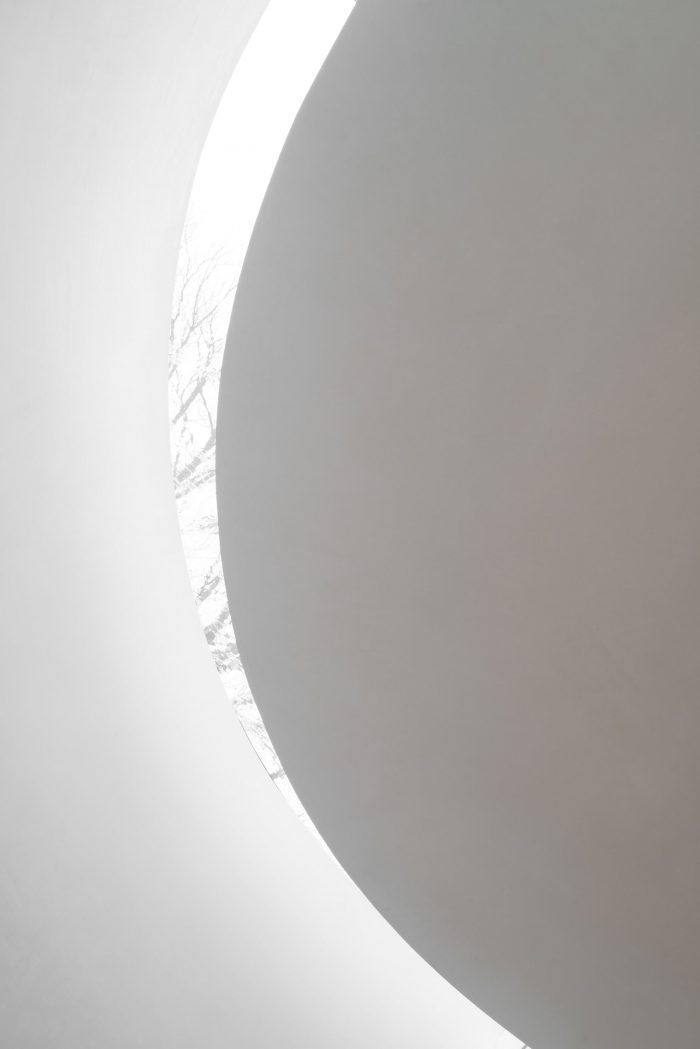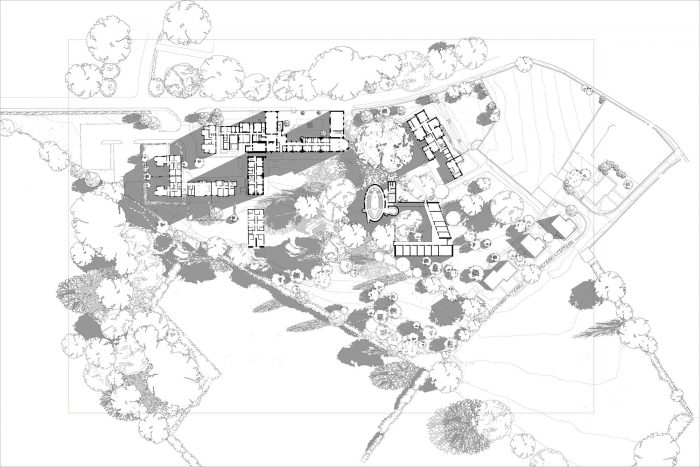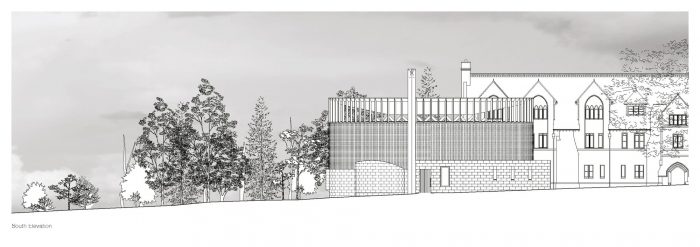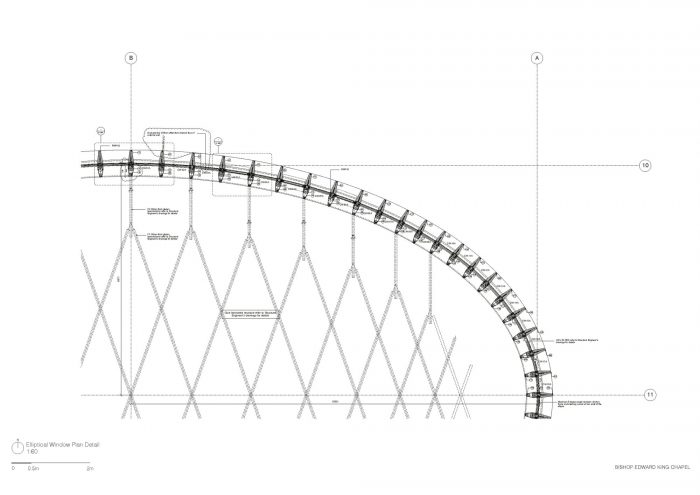客户要求为里彭神学院建造一座新的小教堂,为居住在牛津郡校园里的两个相互关联的群体服务,即大学社区和小型宗教团体贝格布罗克修女会的修女们。该教堂取代了现有的由乔治-埃德蒙-斯切特在十九世纪末设计的教堂,后来证明该教堂太小,无法满足学院目前的需要。设计方案要求,小教堂应能满足两个团体的各种崇拜需求,并适合社区聚会和个人祈祷。
The client brief sought a new chapel for Ripon Theological College, to serve the two interconnected groups resident on the campus in Oxfordshire, the college community and the nuns of a small religious order, the Sisters of Begbroke. The chapel replaces the existing one, designed by George Edmund Street in the late nineteenth century, which had since proved to be too small for the current needs of the college. The brief asked for a chapel that would accommodate the range of worshipping needs of the two communities in a collegiate seating arrangement, and would be suitable for both communal gatherings and personal prayer.
此外,简介还设想了一个独立的空间,供修女们诵读他们的办公室,一个宽敞的圣器室,以及必要的辅助设施。除了这些概要要求之外,简介还列出了客户对小教堂的期望,首先是作为 “个人与神灵相遇的地方”,使居住者能够创造性地思考空间和礼仪之间的关系。客户用菲利普-拉金的诗《去教堂》中的话来概括他们对这个项目的期望:”这是一个严肃的地球上的严肃的房子……他曾经听说,在这里适合成长为智者……”。
In addition the brief envisioned a separate space for the Sisters to recite their offices, a spacious sacristy, and the necessary ancillary accommodation. Over and above these outline requirements, the brief set out the clients’ aspirations for the chapel, foremost as ‘a place of personal encounter with the numinous’ that would enable the occupants to think creatively about the relationship between space and liturgy. The client summarised their aspirations for the project with Philip Larkin’s words from his poem Church Going, ‘ A serious house on serious earth it is…which, he once heard, was proper to grow wise in…’.
场地上有一棵巨大的山毛榉树,位于山顶上。 面对山毛榉和后面的学院建筑,在高地上有一圈成熟的树木,俯瞰着延伸到加辛顿的山谷。这片空地有它自己的特点,充满了风和光以及树叶的沙沙声。该地块的这些优势也带来了重大的规划限制。学院现有的建筑具有相当的历史意义。G.E. Street是维多利亚时代的著名建筑师,学院的主楼和其南面的牧师住宅都被列为二级*。
On the site is an enormous beech tree on the brow of the hill. Facing away from the beech and the college buildings behind, there is ring of mature trees on high ground overlooking the valley that stretches away towards Garsington. This clearing has its own particular character, full of wind and light and the rustling of leaves. These strengths of the site also presented significant planning constraints. The college’s existing buildings are of considerable historical importance. G.E. Street was a prominent architect of the Victorian Age and both the main college building and vicarage to its south are Grade II* listed.
在南牛津郡地方计划中,该场地被指定在绿化带内,而且从西边的山谷中可以看到相当远的地方。场地附近有很多成熟的树木,东部边界有一组树木保护令。设计需要与全景的特征相结合,并保护大学校园的环境和周围的树木。调解这些相互交织的规划敏感性需要与南牛津郡区议会、英国遗产和当地居民进行广泛的协商。
The site is designated within the Green Belt in the South Oxfordshire Local Plan and is also visible from a considerable distance across the valley to the west. The immediate vicinity of the site is populated with mature trees and has a Tree Preservation Order applied to a group at the eastern boundary. The design needed to integrate with the character of the panorama and preserve the setting of the college campus and the surrounding trees. The mediation of these interlocked planning sensitivities required extensive consultation with South Oxfordshire District Council, English Heritage and local residents.
这个项目的出发点是Seamus Heaney诗歌《Lightenings viii》中心的隐藏词 “nave”。这个词描述了教堂的中心空间,但与 “navis”(船)同源,也可以指转动的车轮的静止中心。从这些词中,出现了两个建筑形象。第一个是地面上的空洞,作为社区的聚会场所,静止的中心。第二个是漂浮在树冠上的精致的船形木质结构,是光线和声音的聚集地。
The starting point for this project was the hidden word ‘nave’ at the centre of Seamus Heaney poem Lightenings viii. The word describes the central space of a church, but shares the same origin as ‘navis’, a ship, and can also mean the still centre of a turning wheel. From these words, two architectural images emerged. The first is the hollow in the ground as the meeting place of the community, the still centre. The second is the delicate ship-like timber structure that floats above in the tree canopy, the gathering place for light and sound.
我们喜欢椭圆的几何形状。为了构建一个椭圆,稳定的圆与线相抗衡,这是关于来回运动。对我们来说,这反映了基督教思想中心的完美和不完美之间的交流的想法。几何学中固有的运动在礼拜堂中通过周边的走廊得到了体现。可以绕着小教堂走一圈,看向中心的更明亮的空间。望向照明的空地的感觉可以追溯到最早的教堂。我们做了一块空地,聚集在灯光下。
We enjoyed the geometry of the ellipse. To construct an ellipse the stable circle is played against the line, which is about movement back and forth. For us this reflected the idea of exchange between perfect and imperfect at the centre of Christian thought. The movement inherent in the geometry is expressed in the chapel through the perimeter ambulatory. It is possible to walk around the chapel, looking into the brighter space in the centre. The sense of looking into an illuminated clearing goes back to the earliest churches. We made a clearing to gather in the light.
从外面看,小教堂是一个单一的石头围墙。我们使用了夹石,在质地和颜色上都与现有学院的石灰岩相称。外墙是绝缘的空腔结构,包括一个弧形的加固砌块的内部叶片和穿孔石的外部叶片。小教堂的底部和附属结构是用灰岩石铺成的,有规律的排列。主教堂的上半部分是以狗齿状石料铺成的墙面,并以狗齿状石料铺成规则的课程。小教堂的墙壁上有一个由天然石片组成的光环。鳍状物位于高性能的双层玻璃前面,安装在隐蔽的金属框架中。
The chapel, seen from the outside, is a single stone enclosure. We have used Clipsham stone which is sympathetic, both in terms of texture and colouration, to the limestone of the existing college. The external walls are of insulated cavity construction, comprising of a curved reinforced blockwork internal leaf and dressed stone outer leaf. The base of the chapel and the ancillary structures are clad in ashlar stone laid in regular courses. The upper section of the main chapel is dressed in cropped walling stone, laid in a dog-tooth bond to regular courses. The chapel wall is surmounted by a halo of natural stone fins. The fins sit in front of high-performance double glazed units, mounted in concealed metal frames.
主教堂和附属建筑的屋顶都是暖棚结构。礼拜堂屋顶的排水管是隐藏在外墙空隙中的雨水管。在暴露在壁橱水平的地方,雨水管被包在铝套中,铝套有青铜阳极氧化处理,并被嵌入到石头鳍中。屋顶和内部框架是自我支撑的,独立于外墙。屋顶和墙壁之间的最小交界处表达了这一点。在外部,屋顶护栏向后退,以减少其在底层建筑上的存在;在内部,屋顶结构的底部上升到外墙,形成一个龙骨的形状,表达了希尼诗中的漂浮的 “navis”。
The roof of the main chapel and the ancillary block are both of warm deck construction. The chapel roof drains to concealed rainwater pipes running through the cavity of the external wall. Where exposed at clerestory level, the rainwater pipes are clad in aluminium sleeves with a bronze anodised finish and recessed into the stone fins. The roof and the internal frame are self-supporting and act independently from the external walls. A minimal junction between the roof and the walls expresses this. Externally the roof parapet steps back to diminish its presence above the clerestorey; inside the underside of the roof structure rises up to the outer walls to form the shape of a keel, expressing the floating ‘navis’ of Heaney’s poem.
内部木材结构由预制的胶合板构成,采用钢制固定装置和完全隐蔽的钢制底板连接。胶合板由视觉等级的云杉层压板组成,经过两部分染色系统的处理,呈现出浅白色的表面。屋顶和柱子的结构表达了椭圆本身的几何结构,在中心和边缘之间用直线摆渡,揭示了两端的两个稳定的焦点,反映在下面祭坛和讲台的双焦点的学院布局中。 当你在小教堂周围移动时,在柱子丛和简单的椭圆墙之间有一种展开的节奏的相互作用。小教堂可以被理解为瓶中之船,即隐藏的 “中殿”。
The internal timber structure is constructed of prefabricated Glulam sections with steel fixings and fully concealed steel base plate connections. The Glulam sections are made up of visual grade spruce laminations treated with a two-part stain system, which gives a light white-washed finish. The structure of roof and columns express the geometrical construction of the ellipse itself, a ferrying between centre and edge with straight lines that reveals the two stable foci at either end, reflected in the collegiate layout below in the twin focus points of altar and lectern. As you move around the chapel there is an unfolding rhythm interplay between the thicket of columns and the simple elliptical walls beyond. The chapel can be understood as a ship in a bottle, the hidden ‘nave’.
Architects: Niall McLaughlin Architects
Year : 2013
Photographs :NAARO
Manufacturers : Stamford Stone Co
Building Contractor : Beard Construction
Quantity Surveyor : Ridge and Partners LLP
Mechanical & Electrical Engineer : Synergy Consulting Engineers
Planning Consultant : Nathaniel Lichfield and Partners
Structural Engineer : Price & Myers
City:OXFORDSHIRE
Country:UNITED KINGDOM

